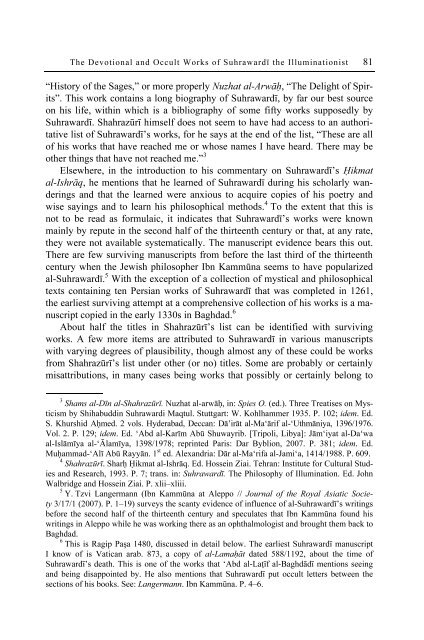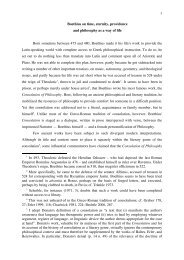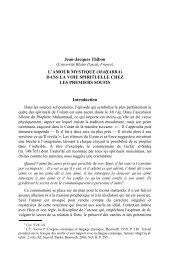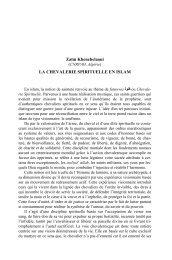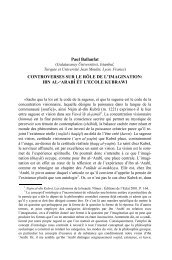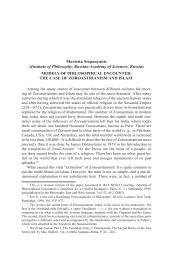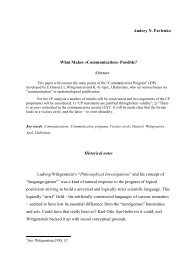The Devotional and Occult Works of Suhrawardī the Illuminationist
The Devotional and Occult Works of Suhrawardī the Illuminationist
The Devotional and Occult Works of Suhrawardī the Illuminationist
You also want an ePaper? Increase the reach of your titles
YUMPU automatically turns print PDFs into web optimized ePapers that Google loves.
<strong>The</strong> <strong>Devotional</strong> <strong>and</strong> <strong>Occult</strong> <strong>Works</strong> <strong>of</strong> <strong>Suhrawardī</strong> <strong>the</strong> <strong>Illuminationist</strong> 81<br />
“History <strong>of</strong> <strong>the</strong> Sages,” or more properly Nuzhat al-Arwāḥ, “<strong>The</strong> Delight <strong>of</strong> Spirits”.<br />
This work contains a long biography <strong>of</strong> <strong>Suhrawardī</strong>, by far our best source<br />
on his life, within which is a bibliography <strong>of</strong> some fifty works supposedly by<br />
<strong>Suhrawardī</strong>. Shahrazūrī himself does not seem to have had access to an authoritative<br />
list <strong>of</strong> <strong>Suhrawardī</strong>’s works, for he says at <strong>the</strong> end <strong>of</strong> <strong>the</strong> list, “<strong>The</strong>se are all<br />
<strong>of</strong> his works that have reached me or whose names I have heard. <strong>The</strong>re may be<br />
o<strong>the</strong>r things that have not reached me.” 3<br />
Elsewhere, in <strong>the</strong> introduction to his commentary on <strong>Suhrawardī</strong>’s Ḥikmat<br />
al-Ishrāq, he mentions that he learned <strong>of</strong> <strong>Suhrawardī</strong> during his scholarly w<strong>and</strong>erings<br />
<strong>and</strong> that <strong>the</strong> learned were anxious to acquire copies <strong>of</strong> his poetry <strong>and</strong><br />
wise sayings <strong>and</strong> to learn his philosophical methods. 4<br />
To <strong>the</strong> extent that this is<br />
not to be read as formulaic, it indicates that <strong>Suhrawardī</strong>’s works were known<br />
mainly by repute in <strong>the</strong> second half <strong>of</strong> <strong>the</strong> thirteenth century or that, at any rate,<br />
<strong>the</strong>y were not available systematically. <strong>The</strong> manuscript evidence bears this out.<br />
<strong>The</strong>re are few surviving manuscripts from before <strong>the</strong> last third <strong>of</strong> <strong>the</strong> thirteenth<br />
century when <strong>the</strong> Jewish philosopher Ibn Kammūna seems to have popularized<br />
al-<strong>Suhrawardī</strong>. 5 With <strong>the</strong> exception <strong>of</strong> a collection <strong>of</strong> mystical <strong>and</strong> philosophical<br />
texts containing ten Persian works <strong>of</strong> <strong>Suhrawardī</strong> that was completed in 1261,<br />
<strong>the</strong> earliest surviving attempt at a comprehensive collection <strong>of</strong> his works is a ma-<br />
nuscript copied in <strong>the</strong> early 1330s in Baghdad. 6<br />
About half <strong>the</strong> titles in Shahrazūrī’s list can be identified with surviving<br />
works. A few more items are attributed to <strong>Suhrawardī</strong> in various manuscripts<br />
with varying degrees <strong>of</strong> plausibility, though almost any <strong>of</strong> <strong>the</strong>se could be works<br />
from Shahrazūrī’s list under o<strong>the</strong>r (or no) titles. Some are probably or certainly<br />
misattributions, in many cases being works that possibly or certainly belong to<br />
3 Shams al-Dīn al-Shahrazūrī. Nuzhat al-arwāḥ, in: Spies O. (ed.). Three Treatises on Mysticism<br />
by Shihabuddin Suhrawardi Maqtul. Stuttgart: W. Kohlhammer 1935. P. 102; idem. Ed.<br />
S. Khurshid Aḥmed. 2 vols. Hyderabad, Deccan: Dā’irāt al-Ma‘ārif al-‘Uthmāniya, 1396/1976.<br />
Vol. 2. P. 129; idem. Ed. ‘Abd al-Karīm Abū Shuwayrib. [Tripoli, Libya]: Jām‘iyat al-Da‘wa<br />
al-Islāmīya al-‘Ālamīya, 1398/1978; reprinted Paris: Dar Byblion, 2007. P. 381; idem. Ed.<br />
Muḥammad-‘Alī Abū Rayyān. 1 st ed. Alex<strong>and</strong>ria: Dār al-Ma‘rifa al-Jami‘a, 1414/1988. P. 609.<br />
4 Shahrazūrī. Sharḥ Ḥikmat al-Ishrāq. Ed. Hossein Ziai. Tehran: Institute for Cultural Studies<br />
<strong>and</strong> Research, 1993. P. 7; trans. in: <strong>Suhrawardī</strong>. <strong>The</strong> Philosophy <strong>of</strong> Illumination. Ed. John<br />
Walbridge <strong>and</strong> Hossein Ziai. P. xlii–xliii.<br />
5 Y. Tzvi Langermann (Ibn Kammūna at Aleppo // Journal <strong>of</strong> <strong>the</strong> Royal Asiatic Socie-<br />
ty 3/17/1 (2007). P. 1–19) surveys <strong>the</strong> scanty evidence <strong>of</strong> influence <strong>of</strong> al-<strong>Suhrawardī</strong>’s writings<br />
before <strong>the</strong> second half <strong>of</strong> <strong>the</strong> thirteenth century <strong>and</strong> speculates that Ibn Kammūna found his<br />
writings in Aleppo while he was working <strong>the</strong>re as an ophthalmologist <strong>and</strong> brought <strong>the</strong>m back to<br />
Baghdad.<br />
6 This is Ragip Paşa 1480, discussed in detail below. <strong>The</strong> earliest <strong>Suhrawardī</strong> manuscript<br />
I know <strong>of</strong> is Vatican arab. 873, a copy <strong>of</strong> al-Lamaḥāt dated 588/1192, about <strong>the</strong> time <strong>of</strong><br />
<strong>Suhrawardī</strong>’s death. This is one <strong>of</strong> <strong>the</strong> works that ‘Abd al-Laṭīf al-Baghdādī mentions seeing<br />
<strong>and</strong> being disappointed by. He also mentions that <strong>Suhrawardī</strong> put occult letters between <strong>the</strong><br />
sections <strong>of</strong> his books. See: Langermann. Ibn Kammūna. P. 4–6.


